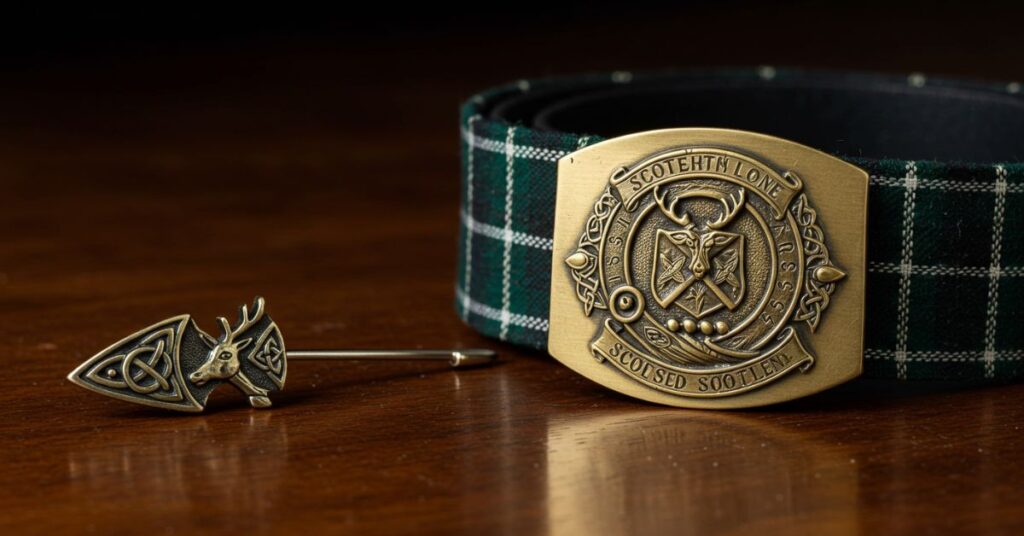When wearing a kilt, the right accessories not only enhance your look but also add personality and authenticity to your traditional Scottish attire. Among the most important kilt accessories are the kilt pin and kilt belt buckle, which serve both functional and decorative purposes. Choosing the perfect ones can make a significant difference in your overall outfit.
In this guide, we’ll explore the importance of kilt pins and belt buckles, how to choose the right ones, and styling tips to complement your kilt outfit.
The Importance of Kilt Accessories
Kilt accessories help complete the look of traditional Scottish attire. Whether you’re attending a wedding, a Highland gathering, or simply embracing your Scottish heritage, these accessories serve two main purposes:
- Functionality – A kilt pin adds weight to the front apron, keeping it in place and preventing it from flying up in windy conditions. Meanwhile, a kilt belt buckle secures the kilt belt and provides additional support.
- Aesthetics – Both accessories enhance the visual appeal of your outfit. They come in various designs, from classic Celtic symbols to custom engravings, allowing you to showcase your style and heritage.
Choosing the Right Kilt Pin
A kilt pin is an essential element of any kilt ensemble, offering both weight and decoration. Here’s what to consider when selecting the perfect one:
1. Style and Design
Kilt pins come in numerous styles, often featuring Scottish emblems, clan crests, or Celtic designs. Some popular designs include:
- Scottish Thistle – Represents resilience and Scotland’s national identity.
- Claymore Sword – Symbolizes strength and bravery.
- Celtic Knotwork – Adds an intricate, timeless look.
- Clan Crests – Ideal for showcasing your heritage.
If you want a modern twist, there are contemporary kilt pins with sleek finishes and minimalist designs that still complement traditional attire.
2. Material and Finish
Kilt pins are commonly made of:
- Sterling Silver – A high-end option with a polished, elegant look.
- Pewter – Lightweight and affordable, yet durable.
- Brass or Gold-Plated – Adds a touch of luxury and warmth to your kilt outfit.
- Antique or Matte Finishes – For a vintage appeal that pairs well with traditional kilts.
3. Size and Weight
- Avoid oversized pins that may weigh down the fabric unnaturally.
- A medium-sized, sturdy pin (approximately 3-4 inches) is ideal for keeping the kilt apron secure without damaging the fabric.
4. Placement of the Kilt Pin
- The pin should be placed about 2-3 inches from the bottom and 1.5-2 inches from the outer edge of the front apron.
- It should go through the top layer only, not both layers, to maintain the natural drape of the kilt.

Selecting the Perfect Kilt Belt Buckle
A kilt belt buckle is more than just a fastening mechanism—it adds character and a finishing touch to your outfit. Here’s how to choose the best one:
1. Compatibility with the Kilt Belt
- Kilt belt buckles are designed to fit wide leather kilt belts (typically 2.25-2.75 inches wide).
- Ensure the buckle’s size matches your belt’s width for a secure fit.
2. Design and Symbolism
Much like kilt pins, kilt belt buckles feature intricate designs, often inspired by Scottish culture:
- Celtic Patterns – Intricate knotwork symbolizes eternity and unity.
- Lion Rampant – A royal emblem that exudes power and pride.
- St. Andrew’s Cross – Represents Scotland’s patron saint.
- Scottish Clans – Customizable buckles featuring your clan’s insignia.
3. Material and Finish
Kilt belt buckles come in various materials to match different kilt styles:
- Polished Chrome – Sleek and modern with a reflective surface.
- Antique Brass or Pewter – Gives a traditional, rustic look.
- Gold-Plated – Ideal for formal events like weddings.
- Black Matte – A contemporary option that pairs well with casual kilts.
4. Formal vs. Casual Wear
- Formal Events – Opt for silver or gold-plated buckles with intricate details.
- Casual or Highland Games – A pewter or antique-finished buckle works best.

How to Match Kilt Pins and Belt Buckles
To create a cohesive look, consider these styling tips:
- Match Metal Finishes – If you have a silver-toned belt buckle, opt for a silver or pewter kilt pin. Mixing metals can look uncoordinated.
- Keep It Subtle – Avoid overly large or flashy designs that overshadow the kilt itself.
- Symbolic Consistency – If your belt buckle has a Celtic knot design, choose a kilt pin with a complementary Celtic pattern for a unified appearance.
- Consider the Event – For formal events, keep accessories refined and polished. For casual settings, you can experiment with bolder designs.
Where to Buy Quality Kilt Accessories
When purchasing a kilt belt buckle and pin consider retailers specializing in authentic Scottish attire like us. Look for:
- Handcrafted Accessories – Higher quality and unique designs.
- Customization Options – Engraved clan crests or initials for a personal touch.
- Durability – Ensure that materials like pewter or sterling silver are used for long-lasting wear.
Online stores and specialty kilt shops often provide a wide range of options tailored to different styles and budgets.
Final Thoughts
Choosing the right kilt pin and kilt belt buckle enhances both the function and style of your kilt outfit. By selecting accessories that reflect your personality, Scottish heritage, or the occasion, you can elevate your traditional attire with confidence.
Whether you prefer classic Celtic designs, clan crests, or contemporary styles, the right combination of accessories ensures your kilt stands out while maintaining authenticity. So, next time you wear a kilt, choose your kilt pin and belt buckle wisely to make a statement with style and tradition.
Frequently Asked Questions
1. Where should I place my kilt pin?
The kilt pin should be placed about 2-3 inches from the bottom and 1.5-2 inches from the side edge of the front apron. It should only go through the top layer of the kilt to avoid restricting movement.
2. Can I wear any pin as a kilt pin?
No, kilt pins are designed to be sturdy and have the right weight for a kilt’s fabric. Regular pins may be too light or flimsy to hold the apron down effectively.
3. Are kilt pins necessary?
While not mandatory, kilt pins help keep the kilt in place, especially in windy conditions. They also add a touch of personality and tradition to your attire.
4. Should I wear a belt buckle with a waistcoat?
No, a kilt belt and belt buckle are usually worn when you are not wearing a waistcoat. A waistcoat provides enough coverage, making a belt unnecessary.
5. Can I customize my kilt belt buckle or kilt pin?
Yes! Many stores offer customization options, such as engraved initials, family clan crests, or unique Scottish designs that reflect personal heritage.







